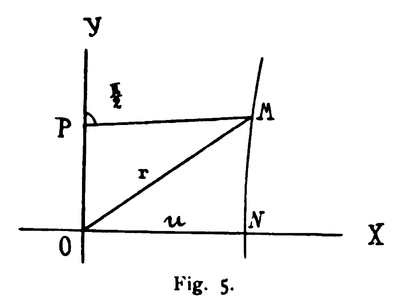of velocity will be completely characterized by the Weierstrass coordinates of point M. We have to put NN' = ON = u. This special case that is illustrated in Fig. 3, forces us to take the hyperbolic cosine of its Lobachevskian abscissa as the time unit of the observer at a certain point of the distance line.
For the observers in M and (Fig. 2) are the related time units
| (22) |
We see from the right angled triangle OMN and , that
or
| (23) |
is constant. If we again take observer in the intersection line of the distance line with the ordinate axis (Fig. 3), then his time unit is , while the time unit τ of the observer in M will be equal to . It is thus
| (24) |
Formula (23) gives
| (25) |
and that is the result of Einstein's investigation.[1]
The relation that is illustrated in formula (23) and Fig. 3 will be distorted, if we make a displacement of the coordinate origin upon the ordinate axis. The line ceases to be a distance line with the abscissa axis as center line. The -axis comes more and more closer to it, intersects it and then leaves it into infinity. The -axis goes away in the same manner. The Lines have the ordinate axis Y as their common perpendicular, thus in Lobachevskian geometry they move the further away from each other, the further they were elongated.

4. Uniform motion
During translations along the distance lines to the X-axis, the bunch of perpendiculars to the X-axes remain unchanged and vice versa. The invariants of second kind of the infinitesimal transformation (10) are those perpendiculars
| (26) |
as it is
In Lobachevskian right angled coordinates the equation of the perpendicular in the point (u,0) is
| (27) |
If we substitute this in formulas (14), then we have
and from this we immediately obtain equation (26).

During uniform motion the relation between the unit of distance and the unit of time is equal to the unit of velocity. Thus it is
or
The image of uniform motion is the perpendicular to the X-axis (Fig. 5). By the
- ↑ A. Einstein, Zur Elektrodynamik bewegter Körper. Ann. d. Phys. 17, 904, 1905



















